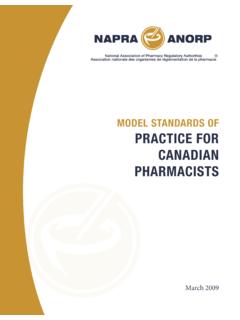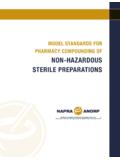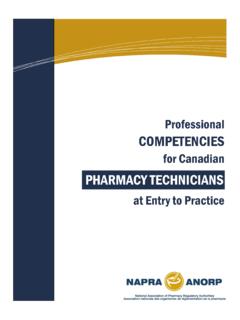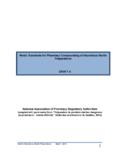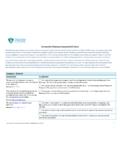Transcription of MODEL STANDARDS OF PRACTICE FOR …
1 MODEL STANDARDS OFPRACTICE FOR canadian PHARMACISTSM arch 2009 National Association of Pharmacy Regulatory Authorities, 2009. All rights reserved. No part of this document may be reproduced in any form by any photographic, electronic, mechanical or other means, or used in any information storage and retrieval system, without the written permission of the National Association of Pharmacy Regulatory Authorities (NAPRA)130 Albert Street, Suite 1800, Ottawa, ON K1P 5G4 (613) 569-9658 Fax (613) 569-9659 E-mail: STANDARDS OF PRACTICE FOR canadian PHARMACISTSNATIONAL ASSOCIATION OF PHARMACY REGULATORY AUTHORITIES (NAPRA)1 INTRODUCTIONThe following MODEL STANDARDS of PRACTICE for canadian pharmacists (MSOP) have been developed by NAPRA based on work by their National Advisory Committee on Pharmacy PRACTICE (NACPP) in combination with best practices in defining competencies and STANDARDS of PRACTICE for health professions.
2 The revised document is also in keeping with the canadian Patient Safety Institute s The Safety Competencies Enhancing Patient Safety Across the Health Professions1 and the canadian pharmacists Association Blueprint for Pharmacy: The Vision for development of these MODEL STANDARDS commenced in late 2007 when the NACPP began a review of the STANDARDS of PRACTICE that were approved in 2003. Draft revised MSOPs were reviewed by stakeholders in late 2008, with comments raising a number of important questions regarding the purpose and ideal format of MSOP (see Appendix I for stakeholders). Careful analysis of these stakeholder comments led to further investigation of ongoing work in STANDARDS of PRACTICE by national regulatory authorities for both pharmacy and other health professions in Canada and abroad. Results highlighted the increasing importance of STANDARDS of PRACTICE for health care professionals in response to shifting and overlapping scopes of PRACTICE and emphasis on accountability of professionals throughout their ,4 In particular, literature documented that STANDARDS of PRACTICE are the fundamental basis of the continuing competence / quality assurance programs mandated by multiple Results also clarified the relationship between documents describing ideal minimum PRACTICE of health professionals ( Good Pharmacy PRACTICE from the International Pharmaceutical Federation [FIP], Good Medical PRACTICE from the UK, and the UK Pharmacy PRACTICE Framework)
3 And STANDARDS of Although some earlier literature refers to the descriptions of ideal minimum PRACTICE as standards5, FIP clarifies that the Framework for Pharmacy PRACTICE should be used as a basis for developing STANDARDS of PRACTICE , while the Royal Pharmaceutical Society of Great Britain has prepared Performance STANDARDS separate from their Pharmacy PRACTICE , 8 The General Medical Council (GMC) of the UK provides the most clear differentiation between descriptions of ideal, minimum PRACTICE and STANDARDS of PRACTICE , stating that to support relicensure the GMC should translate Good Medical PRACTICE into a framework against which individual doctors PRACTICE can be appraised and objectively assessed .10 Current work by the GMC has derived generic STANDARDS of PRACTICE from Good Medical PRACTICE that cover the core requirements of good Importantly the GMC also specifies that practitioners will be held accountable to these core STANDARDS of PRACTICE as a key component of the re-licensure keeping with these best practices and based on stakeholder comments, NAPRA reconsidered the format of the MSOP.
4 The format originally proposed for the revised MSOP was based on the format from the 2003 MSOP which was, in turn, based on the then current literature describing the development of competency-based STANDARDS of ,13 This format was particularly useful for pharmacy in Canada in the early 2000 s as the MSOP needed to incorporate the fundamental shift in PRACTICE toward the provision of pharmaceutical detail was required in the 2003 MSOP to clearly differentiate this form of PRACTICE from clinical pharmacy services. However, given the current broad acceptance of the principles of pharmaceutical care, in combination with the broadening scope of pharmacy PRACTICE in Canada and the developments The GMC requires physicians to revalidate their competence to PRACTICE on a regular basis in order to maintain their license to PRACTICE .
5 This re-licensure process is termed STANDARDS OF PRACTICE FOR canadian PHARMACISTSNATIONAL ASSOCIATION OF PHARMACY REGULATORY AUTHORITIES (NAPRA)2in the structure of STANDARDS of PRACTICE in all of the health professions, it is recognized this format is no longer the most appropriate for NAPRA s MSOP. Instead, it is recommended that the current version of the Professional Competencies for canadian pharmacists at Entry to PRACTICE (2007) remain unchanged and that future revisions of these competencies consider incorporating the detail contained in the previous MSOP to create a more complete description of ideal, minimum pharmacist s PRACTICE . With this recommendation, the MSOP were then redrafted to select specific, measurable activities from the 2007 Competencies that are key both to protecting the public and to safe and effective pharmacist s PRACTICE .
6 In addition, in recognition of the rapidly changing scope of pharmacy PRACTICE in Canada, the MSOP have incorporated pharmacist s activities that are currently authorized in a number of canadian provinces but that were not specified as part of the patient care competency in NAPRA s 2007 Competencies. Examples include extending prescriptions or administration of medications by injection. It is anticipated that future revisions in the Competencies for canadian pharmacists at Entry to PRACTICE and/or descriptions of ideal minimum PRACTICE ( Good Pharmacist s PRACTICE ) will include these activities as part of the existing patient-care competency for canadian pharmacists . Finally, the MSOP incorporate the Supplemental STANDARDS of PRACTICE for Schedule II and III Drugs, with readers referred to this document for detailed compliance requirements related to these is also important to emphasize that the MSOP are written primarily for pharmacy regulatory authorities with the goal of specifying the STANDARDS against which pharmacist s performance can be judged when the pharmacists are undertaking the activities required for safe and effective pharmacy PRACTICE .
7 Regulators will also use these MSOP to explain the responsibilities of pharmacists to their stakeholders in a meaningful and understandable manner. NAPRA does recognize that many others will refer to these MSOP, including practising pharmacists , the Pharmacy Examining Board of Canada, educators, and regulators from other professions. The language used within these MSOP, therefore, uses commonly recognized terms rather than expressions which have meaning primarily to pharmacy final clarification requested by many stakeholders requires the explicit statement that the MSOP are minimum STANDARDS of PRACTICE that all licensed pharmacists must meet. The MSOP are not applicable only to pharmacists at entry to PRACTICE . Furthermore, NAPRA acknowledges that there are a number of professional roles fulfilled by pharmacists as drawn from the 2007 Professional Competencies.
8 These roles can be categorized into: patient care drug information drug distribution management educationNAPRA recognizes that not all pharmacists perform each of the roles as part of their daily work. For example, pharmacists may provide patient care and yet not be involved in the distribution of medications or pharmacy management. However, regardless of a pharmacist s position or PRACTICE context, it is NAPRA s intention that when a pharmacist does perform a specific role, then (s)he must perform it to the level specified in the STANDARDS . Furthermore, when performing a specific role, the pharmacists must meet all of the MSOP associated with this role. The MSOP have been formatted to ensure clarity and facilitate compliance by pharmacists fulfilling specific roles in their daily STANDARDS OF PRACTICE FOR canadian PHARMACISTSNATIONAL ASSOCIATION OF PHARMACY REGULATORY AUTHORITIES (NAPRA)3 FORMATThe format adopted for the MSOP draws from ongoing work from the UK GMC10, 11, where the STANDARDS were broadly categorized into four domains related to medical expertise, safety and quality, communication, partnership and teamwork, and maintaining trust.
9 Review of STANDARDS and PRACTICE descriptions from a number of organizations led to modifications in these categorizations to ensure consistency of the MSOP with priorities in canadian health care such as collaborative , 9,15 The four domains of MSOP for canadian pharmacists are: Expertise in medications and medication-use Collaboration Safety and Quality Professionalism and EthicsIt is emphasized that the central domains for pharmacists are the two entitled medication and medication-use expertise, and collaboration. The remaining domains refer to critical attributes that are required of pharmacists to successfully achieve the MSOP in their two central domains. Such a MODEL of central professional activities and supportive / underlying attributes is consistent with NAPRA s 2003 MODEL STANDARDS , the Association of Faculties of Pharmacy of Canada s (AFPC) Educational Outcomes for a Baccalaureate Pharmacy Graduate in Canada16, and the Royal College of Physicians and Surgeons of Canada s CanMeds competency framework17.
10 Finally, STANDARDS from multiple international and provincial pharmacy regulatory authorities were also reviewed to allow a thorough selection of activities key to quality pharmacy , 18-20 The resulting framework for the MSOP, therefore, incorporates four domains of STANDARDS of PRACTICE . Within each of these domains the MSOP are grouped under general standard statements to provide structure and ease of reading as follows:General StandardModel STANDARDS of PracticeExpertise in medications and medication-use .. pharmacists maintain their competence. pharmacists apply their medication and medication-use expertise while performing their daily activities. pharmacists provide evidence of application of their medication and medication-use expertise through .. pharmacists work constructively with students, peers and members of the inter-professional team.
